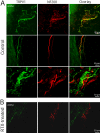Sensing of blood pressure increase by transient receptor potential vanilloid 1 receptors on baroreceptors
- PMID: 19726694
- PMCID: PMC2784714
- DOI: 10.1124/jpet.109.160473
Sensing of blood pressure increase by transient receptor potential vanilloid 1 receptors on baroreceptors
Abstract
The arterial baroreceptor is critically involved in the autonomic regulation of homoeostasis. The transient receptor potential vanilloid 1 (TRPV1) receptor is expressed on both somatic and visceral sensory neurons. Here, we examined the TRPV1 innervation of baroreceptive pathways and its functional significance in the baroreflex. Resiniferatoxin (RTX), an ultrapotent analog of capsaicin, was used to ablate TRPV1-expressing afferent neurons and fibers in adult rats. Immunofluorescence labeling revealed that TRPV1 immunoreactivity was present on nerve fibers and terminals in the adventitia of the ascending aorta and aortic arch, the nodose ganglion neurons, and afferent fibers in the solitary tract of the brainstem. RTX treatment eliminated TRPV1 immunoreactivities in the aorta, nodose ganglion, and solitary tract. Renal sympathetic nerve activity, blood pressure, and heart rate were recorded in anesthetized rats. The baroreflex was triggered by lowering and raising blood pressure through intravenous infusion of sodium nitroprusside and phenylephrine, respectively. Inhibition of sympathetic nerve activity and heart rate by the phenylephrine-induced increase in blood pressure was largely impaired in RTX-treated rats. The maximum gain of the baroreflex function was significantly lower in RTX-treated than vehicle-treated rats. Furthermore, blocking of TRPV1 receptors significantly blunted the baroreflex and decreased the maximum gain of baroreflex function in the high blood pressure range. Our findings provide important new information that TRPV1 is expressed along the entire baroreceptive afferent pathway. TRPV1 receptors expressed on baroreceptive nerve endings can function as mechanoreceptors to detect the increase in blood pressure and maintain the homoeostasis.
Figures







References
-
- Birder LA, Nakamura Y, Kiss S, Nealen ML, Barrick S, Kanai AJ, Wang E, Ruiz G, De Groat WC, Apodaca G, et al. ( 2002) Altered urinary bladder function in mice lacking the vanilloid receptor TRPV1. Nat Neurosci 5:856–860 - PubMed
-
- Böck P, Gorgas K. (1976) Fine structure of baroreceptor terminals in the carotid sinus of guinea pigs and mice. Cell Tissue Res 170:95–112 - PubMed
Publication types
MeSH terms
Substances
Grants and funding
LinkOut - more resources
Full Text Sources

